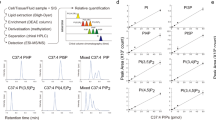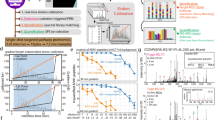Abstract
Class I phosphoinositide-3-kinase (PI3K) isoforms generate the intracellular signaling lipid, phosphatidylinositol(3,4,5)trisphosphate (PtdIns(3,4,5)P3). PtdIns(3,4,5)P3 regulates major aspects of cellular behavior, and the use of both genetic and pharmacological intervention has revealed important isoform-specific roles for PI3Ks in health and disease. Despite this interest, current methods for measuring PtdIns(3,4,5)P3 have major limitations, including insensitivity, reliance on radiolabeling, low throughput and an inability to resolve different fatty-acyl species. We introduce a methodology based on phosphate methylation coupled to high-performance liquid chromatography–mass spectrometry (HPLC-MS) to solve many of these problems and describe an integrated approach to quantify PtdIns(3,4,5)P3 and related phosphoinositides (regio-isomers of PtdInsP and PtdInsP2 are not resolved). This methodology can be used to quantify multiple fatty-acyl species of PtdIns(3,4,5)P3 in unstimulated mouse and human cells (≥105) or tissues (≥0.1 mg) and their increase upon appropriate stimulation.
This is a preview of subscription content, access via your institution
Access options
Subscribe to this journal
Receive 12 print issues and online access
$259.00 per year
only $21.58 per issue
Buy this article
- Purchase on Springer Link
- Instant access to full article PDF
Prices may be subject to local taxes which are calculated during checkout





Similar content being viewed by others
References
Cantley, L.C. The phosphoinositide 3-kinase pathway. Science 296, 1655–1657 (2002).
Vanhaesebroeck, B. et al. Synthesis and function of 3-phosphorylated inositol lipids. Annu. Rev. Biochem. 70, 535–602 (2001).
Vanhaesebroeck, B., Vogt, P.K. & Rommel, C. PI3K: from the bench to the clinic and back. Curr. Top. Microbiol. Immunol. 347, 1–19 (2010).
Rusten, T.E. & Stenmark, H. Analyzing phosphoinositides and their interacting proteins. Nat. Methods 3, 251–258 (2006).
Sauer, K., Huang, Y.H., Lin, H., Sandberg, M. & Mayr, G.W. Phosphoinositide and inositol phosphate analysis in lymphocyte activation. Curr. Protoc. Immunol. 87, 11.1.1–11.1.46 (2009).
Guillou, H., Stephens, L.R. & Hawkins, P.T. Quantitative measurement of phosphatidylinositol 3,4,5-trisphosphate. Methods Enzymol. 434, 117–130 (2007).
Milne, S.B., Ivanova, P.T., DeCamp, D., Hsueh, R.C. & Brown, H.A. A targeted mass spectrometric analysis of phosphatidylinositol phosphate species. J. Lipid Res. 46, 1796–1802 (2005).
Wenk, M.R. et al. Phosphoinositide profiling in complex lipid mixtures using electrospray ionization mass spectrometry. Nat. Biotechnol. 21, 813–817 (2003).
Pettitt, T.R., Dove, S.K., Lubben, A., Calaminus, S.D. & Wakelam, M.J. Analysis of intact phosphoinositides in biological samples. J. Lipid Res. 47, 1588–1596 (2006).
Ivanova, P.T., Milne, S.B., Myers, D.S. & Brown, H.A. Lipidomics: a mass spectrometry based systems level analysis of cellular lipids. Curr. Opin. Chem. Biol. 13, 526–531 (2009).
Postle, A.D., Wilton, D.C., Hunt, A.N. & Attard, G.S. Probing phospholipid dynamics by electrospray ionisation mass spectrometry. Prog. Lipid Res. 46, 200–224 (2007).
Vadnal, R.E. & Parthasarathy, R. The identification of a novel inositol lipid, phosphatidylinositol trisphosphate (PIP3), in rat cerebrum using in vivo techniques. Biochem. Biophys. Res. Commun. 163, 995–1001 (1989).
Ogiso, H. & Taguchi, R. Reversed-phase LC/MS method for polyphosphoinositide analyses: changes in molecular species levels during epidermal growth factor activation in A431 cells. Anal. Chem. 80, 9226–9232 (2008).
Vasudevan, K.M. et al. AKT-independent signalling downstream of oncogenenic PIK3CA mutations in human cancer. Cancer Cell 16, 21–32 (2009).
Oku, N. et al. Isolation, structural elucidation, and absolute stereochemistry of enigmazole A, a cytotoxic phosphomacrolide from the Papua New Guinea marine sponge Cinachyrella enigmatica. J. Am. Chem. Soc. 132, 10278–10285 (2010).
Corey, S. et al. Granulocyte macrophage-colony stimulating factor stimulates both association and activation of phosphoinositide 3OH-kinase and src-related tyrosine kinase(s) in human myeloid derived cells. EMBO J. 12, 2681–2690 (1993).
Folch, J., Lees, M. & Sloane Stanley, G.H. A simple method for the isolation and purification of total lipides from animal tissues. J. Biol. Chem. 226, 497–509 (1957).
Cadwallader, K.A. et al. Regulation of phosphatidylinositol 3-kinase activity and phosphatidylinositol 3,4,5-trisphosphate accumulation by neutrophil priming agents. J. Immunol. 169, 3336–3344 (2002).
Traynor-Kaplan, A.E., Harris, A.L., Thompson, B.L., Taylor, P. & Sklar, L.A. An inositol tetrakisphosphate-containing phospholipid in activated neutrophils. Nature 334, 353–356 (1988).
Guillou, H. et al. Use of the GRP1 PH domain as a tool to measure the relative levels of PtdIns(3,4,5)P3 through a protein-lipid overlay approach. J. Lipid Res. 48, 726–732 (2007).
Stephens, L.R., Hughes, K.T. & Irvine, R.F. Pathway of phosphatidylinositol(3,4,5)-trisphosphate synthesis in activated neutrophils. Nature 351, 33–39 (1991).
Li, Z. et al. Roles of PLC-beta2 and -beta3 and PI3Kgamma in chemoattractant-mediated signal transduction. Science 287, 1046–1049 (2000).
Condliffe, A.M. et al. Sequential activation of class IB and class IA PI3K is important for the primed respiratory burst of human but not murine neutrophils. Blood 106, 1432–1440 (2005).
Van Keymeulen, A. et al. To stabilize neutrophil polarity, PIP3 and Cdc42 augment RhoA activity at the back as well as signals at the front. J. Cell Biol. 174, 437–445 (2006).
Gustin, J.P. et al. Knockin of mutant PIK3CA activates multiple oncogenic pathways. Proc. Natl. Acad. Sci. USA 106, 2835–2840 (2009).
Vitolo, M.I. et al. Deletion of PTEN promotes tumorigenic signaling, resistance to anoikis, and altered response to chemotherapeutic agents in human mammary epithelial cells. Cancer Res. 69, 8275–8283 (2009).
Xie, T. et al. The alternative stimulatory G protein alpha-subunit XLalphas is a critical regulator of energy and glucose metabolism and sympathetic nerve activity in adult mice. J. Biol. Chem. 281, 18989–18999 (2006).
Rouzer, C.A. et al. Lipid profiling reveals arachidonate deficiency in RAW264.7 cells: structural and functional implications. Biochemistry 45, 14795–14808 (2006).
Painter, G.F. et al. General synthesis of 3-phosphorylated myo-inositol phospholipids and derivatives. J. Chem. Soc. 1, 923–935 (1999).
Anderson, K.E. et al. CD18-dependent activation of the neutrophil NADPH oxidase during phagocytosis of Escherichia coli or Staphylococcus aureus is regulated by class III but not class I or II PI3Ks. Blood 112, 5202–5211 (2008).
Acknowledgements
We thank G. Kelsey (Babraham Institute) for providing mice, E. Ivanova for technical assistance and A. Segonds-Pichon for statistical analysis. V.J. acknowledges the support of the community under a Marie Curie Intra-European Fellowship for Career Development. This work was supported by the Biotechnology and Biological Sciences Research Council and European Union FP7 LipidomicNet (#202272).
Author information
Authors and Affiliations
Contributions
J.C. and K.E.A. designed and performed experiments, developed methods, analyzed data and contributed to writing the manuscript; V.J. designed and performed PKB experiments; T.S.S. performed experiments; F.K. designed experiments (Fig. 5 and Supplementary Figs. 9 and 10) to generate samples for analysis; M.J.O.W. developed methods and provided reagents; and L.R.S. and P.T.H. designed the study/experiments, developed methods, analyzed data and wrote the manuscript.
Corresponding authors
Ethics declarations
Competing interests
The authors declare no competing financial interests.
Supplementary information
Supplementary Text and Figures
Supplementary Figures 1–10, Supplementary Tables 1–2, Supplementary Data 1–2 (PDF 901 kb)
Rights and permissions
About this article
Cite this article
Clark, J., Anderson, K., Juvin, V. et al. Quantification of PtdInsP3 molecular species in cells and tissues by mass spectrometry. Nat Methods 8, 267–272 (2011). https://doi.org/10.1038/nmeth.1564
Received:
Accepted:
Published:
Issue Date:
DOI: https://doi.org/10.1038/nmeth.1564
This article is cited by
-
Deep-profiling of phospholipidome via rapid orthogonal separations and isomer-resolved mass spectrometry
Nature Communications (2023)
-
Biomolecular condensates create phospholipid-enriched microenvironments
Nature Chemical Biology (2023)
-
A small-molecule PI3Kα activator for cardioprotection and neuroregeneration
Nature (2023)
-
Supercritical fluid chromatography-mass spectrometry enables simultaneous measurement of all phosphoinositide regioisomers
Communications Chemistry (2022)
-
A mass spectrometric method for in-depth profiling of phosphoinositide regioisomers and their disease-associated regulation
Nature Communications (2022)



